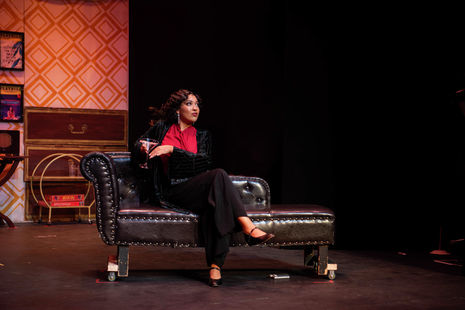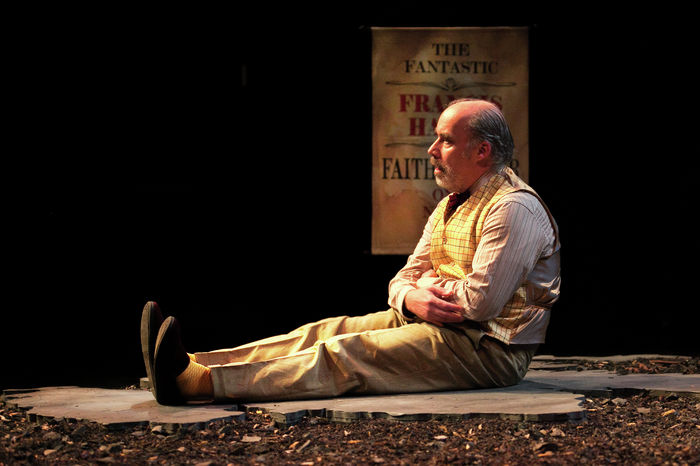The Drowsy Chaperone: Wake Up and Get Yourself a Ticket
An immensely talented cast dazzle in this laugh-out-loud, non-stop celebratory love letter to musical theatre

The Drowsy Chaperone is a show within a show that centres around a lovably entertaining and comfortingly familiar farce while dripping with the glitz and glamour of a Jazz Age musical. It unashamedly picks out the best of this joyous genre while laughing at its absurdity. A plethora of farcical tropes shine in their unwavering delight as The Drowsy Chaperone’s first success is in its identity as a comedy musical. Take two gangsters undercover as pastry chefs, multiple weddings, throw in a case of mistaken identity and a love song that is sung blindfolded on roller skates, and it is clear that Bob Martin and Don McKellar’s book has it all… multiplied by a hundred. How The Drowsy Chaperone brings itself up to date, though, is in its framing. The whole show takes place in the living room of the anonymous ‘Man in Chair’ (Benjamin Anderson). In what appears to be the future of every theatre nerd, the Man in Chair takes the audience through the time capsule of a show from the comfort of his armchair, playing the music through his gramophone. The homely set designed by Grace Heslin complimented his quiet tenderness at the side of the stage, and provided welcome moments of vulnerability and flickers of reality. We watch the musical through the eyes of a man who relies on it for comfort and escape.
"It unashamedly picks out the best of this joyous genre while laughing at its absurdity"
The Drowsy Chaperone kept the audience laughing. When every character is delightfully outrageous, the performances can never be too big, and this cast threw everything they had into it. Directors Jessi Rogers and Beck Walker handle the already-fruitful content of the book masterfully, and the self-aware comedy that lovingly mocks the tropes of 1920s musical theatre was sophisticated and levelled. The audience were never hit with the same joke twice, but were pummelled nonetheless. Rogers and Walker also navigated the difficult subtlety of the fictional history of the 1920’s show. Thanks to the Man in Chair’s commentary, we learn of the actors’ off stage dynamics as they seep onto the stage. For instance, ‘Jane Roberts was an emerging star, but Beatrice Stockwell was already well established and a force to contend with’ he says. The sense that each of the cast were playing an actor playing a role did not go unnoticed and it successfully added a simmering layer of subtle realism to the otherwise larger-than-life show.
The Drowsy Chaperone is brimming with skilled comic actors. A stand-out character actor was undeniably the audacious Latin lady-lover Aldolpho (Jude Ashcroft), whose command over the audience was apparent from the very first tap of his cane. Noah Hammond stole scenes as the infinitely unimpressed French butler ‘Underling’, managing to bag laughs with few words. Finally, the chemistry (and violent New York accents) of the pun-filled gangster double act (Isobel Guthrie and Jamie Ellis) was lapped up by the audience.
"The only trouble is that with singing this good, you just want more"
The talent of this cast did not stop at their comedic ability. The singing and dancing demands of this show were met and surpassed. The only trouble is that with singing this good, you just want more (Jordan Moxey’s ‘Trix’ comes to mind here, a voice like that should not be kept to the very end). In particular, Isabel Beresford-Cole was excellent as the show’s title role. Her voice was technically brilliant and her vocal choices conveyed the aged professionalism of her actor persona first, while also enjoying the indulgences of her rousing role. The voice of leading lady Janet van de Graaff (Neela Nee) was also wonderful, and despite what she says in her song ‘I don’t want to show off’ – she has every right to.
The choreography of Gina Stock and Em Sparks was the core of this epic show. They managed both the sugary spectacle of show-stopping chorus numbers, and used dance as a tool to reinforce the comedy. The sequences of splits, lifts and cartwheels accompanying ‘I Don’t Want to Show Off’ is a good example of this. The cast thrived in the smaller dances (this show is worth seeing for Joseph Lucas and Elliot Barker’s tap dancing alone). While it initially felt like the ensemble numbers required a lot of visible concentration, they soon eased into these bigger dances and allowed themselves to have a lot of fun.
With Man in Chair ending as Man in Aeroplane Centre Stage, this show reminds its audience of the unbridled optimism that musical theatre provides. Perhaps more importantly, The Drowsy Chaperone tells us to hold on to these precious comforts, even if all it does is give you ‘a little tune to carry with you in your head for when you’re feeling blue.'
The Drowsy Chaperone runs from the 31st October to the 4th November at the ADC Theatre
 News / Clare Hall spent over £500k opposing busway 24 December 2025
News / Clare Hall spent over £500k opposing busway 24 December 2025 Comment / The ‘class’ of Cambridge24 December 2025
Comment / The ‘class’ of Cambridge24 December 2025 News / Caius mourns its tree-mendous loss23 December 2025
News / Caius mourns its tree-mendous loss23 December 2025 News / Girton JCR publishes open letter expressing solidarity with Palestine25 December 2025
News / Girton JCR publishes open letter expressing solidarity with Palestine25 December 2025 Comment / Yes, I’m brown – but I have more important things to say22 December 2025
Comment / Yes, I’m brown – but I have more important things to say22 December 2025










